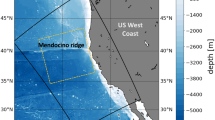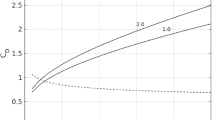Summary
The influence of turbulent diffusion of heat and salt on wind-produced linear internal waves in shallow waters is investigated. Diffusion of heat, salt and momentum are parameterized using eddy coefficients. The damping effect of diffusion of heat and salt is small compared to that of momentum, as is suggested from physical considerations. It is largest at those depths where the velocity gradients are large due to other physical processes; in this model the velocity gradients are large in the Ekman layers at the surface and at the bottom. In contrast to momentum, diffusion of heat and salt do not contribute to the vertical transport of energy but only dissipate energy. Le Blond [1965] found that the shift of the resonance point due to viscosity should be neutralized when identical eddy coefficients for heat, salt and momentum are used. This was not found in these calculations where a shift towards higher wave numbers takes place with increasing damping, independently of the damping mechanism.
Zusammenfassung
In einem linearisierten Gleichungssystem wird der Einfluß von turbulenter Wärmeleitung und Vermischung auf windbedingte interne Wellen in einem Flachmeer untersucht. Wärmeleitung, vermischung und Impulstransport werden durch Austauschkoeffizienten parametrisiert. Wie auch aus physikalischen Überlegungen naheliegt, ist die Dämpfung aufgrund turbulenter Wärmeleitung und Vermischung klein gegenüber der viskosen Dämpfung. Wärmeleitung und Vermischung wirken jeweils in den Tiefen am stärksten, in denen aufgrund anderer physikalischer Vorgänge, hier ist es der Aufbau der Ekman-Schicht an der Oberfläche und am Boden, die Strömungsgradienten am größten sind. Im Gegensatz zum Impuls tragen sie jedoch nicht zum vertikalen Energietransport bei. Die Aussage Le Blonds [1965], daß nämlich bei gleichen Impuls- und Vermischungsaustauschkoeffizienten die Frequenzverschiebung der Resonanzstelle aufgehoben werde, konnte nicht bestätigt werden. Unabhängig vom Dämpfungsmechanismus folgt mit zunehmender Dämpfung eine Verschiebung der Resonanzstelle zu größeren Wellenzahlen.
Résumé
On étudie l'influence de la diffusion turbulente de la chaleur et de la teneur en sel sur les ondes internes linéaires produites par le vent dans les eaux peu profondes. La diffusion de la chaleur, de la teneur en sel et de la quantité de mouvement sont paramétrées en utilisant des coefficients de turbulence. L'amortissement de la diffusion de la chaleur et de la teneur en sel est faible en comparaison de celui de la quantité de mouvement, comme le suggèrent des considérations physiques. Il est maximal aux profondeurs où les gradients de vitesse sont de valeurs élevées, en raison d'autres processus physiques; dans ce modèle, les gradients de vitesse sont élevés dans les couches d'Ekman, à la surface et au fond. Au contraire de la quantité de mouvement, la diffusion de chaleur et de teneur en sel ne contribue pas au transport vertical de l'énergie, mais seulement à sa dissipation. LeBlond [1965] a trouvé que le déplacement du point de résonance dû à la viscosité serait neutralisé quand on utilise des coefficients de turbulence identiques pour la chaleur, la teneur en sel et la quantité de mouvement. Cela ne se vérifie pas dans nos calculs où un déplacement vers les nombres d'ondes croissants se produit lorsque l'amortissement augmente, indépendamment du mécanisme d'amortissement.
Similar content being viewed by others
Abbreviations
- A v :
-
vertical eddy coefficient for heat
- B v :
-
vertical eddy coefficient for salt
- c p :
-
specific heat
- f :
-
inertial frequency
- g :
-
gravitational acceleration
- p :
-
pressure
- P L :
-
air pressure
- Prt :
-
turbulent Prandtl number
- S :
-
salinity
- s :
-
specific salinity
- T :
-
temperature
- u :
-
x component of the velocity vector
- v :
-
velocity vector
- v :
-
y component of the velocity vector
- w :
-
z component of the velocity vector
- y :
-
coefficient of bottom friction
- α:
-
constant
- β:
-
constant
- ζ:
-
surface elevation
- η:
-
y component of the wave number vector
- ϰ:
-
x component of the wave number vector
- μ v :
-
vertical eddy coefficient for momentum
- ϱ:
-
density
- τ:
-
wind stress
- Ψ:
-
symbol for hydrodynamic variables
- ω:
-
frequency
References
Käse, R. H. and C. L. Tang, 1976: Spectra and coherence of wind-generated internal waves. J. Fish. Res. Bd Can.33, 2323–2328.
Krauss, W., 1972: Wind-generated internal waves and inertial-period motions. Dt. hydrogr. Z.25, 241–250.
Krauss, W., 1976: On currents, internal and inertial waves in a stratified ocean due to variable winds. Part 1 and 2. Dt. hydrogr. Z.29, 87–96, 119–135.
LeBlond, P. H., 1965: Über den Einfluß von Reibung und Vermischung auf interne Wellen. Kieler Meeresforsch.21, 127–131.
Lindzen, R. S. and H.-L. Kuo, 1969: A reliable method for the numerical integration of a large class of ordinary and partial differential equations. Month. Weather Rev.97, 732–734.
Magaard, L., 1973: On the generation of internal gravity waves by meteorological forces. Mem. Soc. R. Sci. Liège. Ser.6, 79–84.
Monin, A. S. and A. M. Yaglom, 1971: Statistical fluid mechanics. Vol. 1: Mechanics of turbulence. (Übers. aus d. Russ.) Cambridge, Mass. and London: MIT (=Mass. Inst. of Technology) Press. XII, 769 S.
Neumann, G. and W. J. Pierson, 1966: Principles of physical oceanography. Englewood Cliffs, N.J.: Prentice-Hall. XII, 545 S.
Rotta, J. C. 1972: Turbulente Strömungen. Stuttgart: Teubner, 267 S.
Zurmühl, R., 1965: Praktische Mathematik. Berlin: Springer.
Author information
Authors and Affiliations
Rights and permissions
About this article
Cite this article
Struve, S. The influence of turbulent diffusion of heat and salt on windproduced internal waves. Deutsche Hydrographische Zeitschrift 31, 83–94 (1978). https://doi.org/10.1007/BF02227006
Received:
Published:
Issue Date:
DOI: https://doi.org/10.1007/BF02227006




